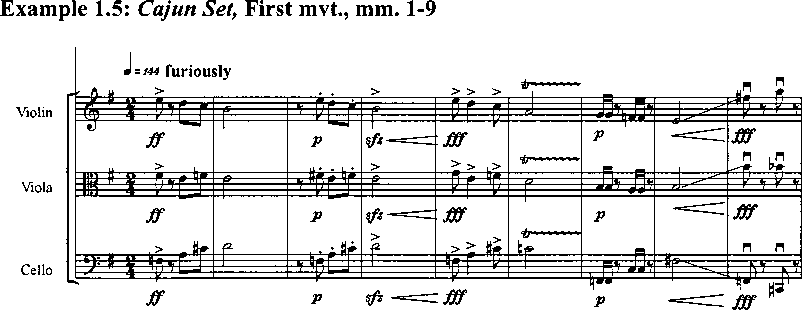34
music are abrupt and unsettling.”60 Larsen’s stop waltz alternates between the triple meter
waltz from the main Gringalet tune and material from the Allegretto section used for the
more “random” interludes.
The form of this movement is quite straightforward. All the melodic material from
the Cajun song is used, though the two sections are initially presented in reversed order.
The A section, based on the Allegretto of Gringalet is marked furiously6λ In Larsen’s
adaptation the bowed strings play it alone and it is characterized by a large range in
dynamics, sudden dynamic changes, increased chromaticism, and abrupt endings. An
accented chromatic tone cluster marked ^begins the piece, and throughout the first
section the harmony is quite compressed. Like the original version, a two measure
descending fragment is repeated three times, now complemented by contrary motion in
the cello. Each statement of this A section ends differently. In its first iteration, it
concludes with a measure long contrary motion glissando (see Example 1.5) akin to the
arrival of the storm in Black Roller.62

The solo guitar presents the first verse of the waltz melody, the B section as shown
Larsen, Libby, “Cajun Set,” (Minneapolis, MN: Libby Larsen Publishing), preface.
61
Though not indicated in the last statement in m. 143, the mood is clearly the same.
62 This occurs in m. 87 of Black Roller.
More intriguing information
1. THE AUTONOMOUS SYSTEMS LABORATORY2. The name is absent
3. Visual Perception of Humanoid Movement
4. Evidence-Based Professional Development of Science Teachers in Two Countries
5. Estimating the Technology of Cognitive and Noncognitive Skill Formation
6. Human Rights Violations by the Executive: Complicity of the Judiciary in Cameroon?
7. The name is absent
8. Economic Evaluation of Positron Emission Tomography (PET) in Non Small Cell Lung Cancer (NSCLC), CHERE Working Paper 2007/6
9. Why unwinding preferences is not the same as liberalisation: the case of sugar
10. sycnoιogιcaι spaces